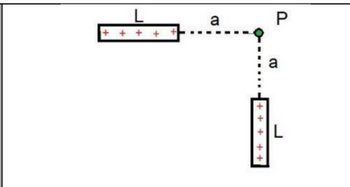Question
1)The resulting electric field vector at a point P that is a = 30 cm from the end of two wires of the same length L = 60 cm and the same charge distribution λ = 2 x 10 -4C/m, and arranged in orthogonal directions, as figure 01 is:
a) E_{R} = - 1, 8 * 10 ^ 6 * (i + j)
b) E_{R} = - 2, 6 * 10 ^ 6 * (i + j)
c) E_{R} = - 4, 1 * 10 ^ 6 * (i + j)
d) E_{R} = - 9, 3 * 10 ^ 6 * (i + j)
e) None

Transcribed Image Text:+
a
+++++
a
Expert Solution
This question has been solved!
Explore an expertly crafted, step-by-step solution for a thorough understanding of key concepts.
Step by stepSolved in 2 steps with 2 images

Knowledge Booster
Similar questions
- The electric field 1/6 of the way from a charge q1 to a charge q2 is zero. How many times larger is q2 than q1 based on the previous statement?arrow_forwardConsider two point charges q1 = -7e and q2 = 2e situated on the %3D x-axis with qı at the origin as shown in the figure below. Suppose that r12 = 3.36 µm and r2p = has a magnitude that is most nearly 4.87 um. Then the net electric field at point P P• r2P 92 T12arrow_forwardConsider an electron that is 1.10-10 m from an alpha particle with charge 3.2.10-¹⁹ C. (a) What is the electric field due to the alpha particle at the location of the electron? The direction of the electric field by the alpha particle at the electron is Ela ate C (b) What is the electric field due to the electron at the location of the alpha particle? The direction of the electric field by the electron at the location of the alpha particle is #J N C |Ele- at a (c) What is the magnitude of the electric force on the electron? ✔N F = = (d) What is the magnitude of the electric force on the alpha particle? Fa= N (e) Do the two forces obey Newton's Laws?arrow_forward
- In the figure below, positive charge q = 7.47 pC is spread uniformly along a thin nonconducting rod of length L = 13.0 cm. (a) What is the magnitude of the electric field produced at point P, at distance R = 6.00 cm from the rod along its perpendicular bisector? __________N/C(b) What is the direction of the field at point P?____________ ° counterclockwise from the +x-axis (please include units so that I can follow your steps easier)arrow_forwardTwo d = 4.40-m nonconducting wires meet at a right angle. One segment carries +2.90 μC of charge distributed uniformly along its length, and the other carries -2.9 µC distributed uniformly along it, as shown in the following figure. K d d ++++ P (a) Find the magnitude and direction of the electric field these wires produce at point P, which is 220.0 cm from each wire. (Assume the +x axis goes to the right.) magnitude direction N/C 。 counterclockwise from the +x direction (b) If an electron is released at P, what are the magnitude and direction of the net force that these wires exert on it? magnitude N direction ° counterclockwise from the +x directionarrow_forwardInside a cathode ray tube, an electron is in the presence of a uniform electric field with a magnitude of 275 N/C. (a) What is the magnitude of the acceleration of the electron (in m/s2)? m/s2 (b) The electron is initially at rest. What is its speed (in m/s) after 1.20 ✕ 10−8 s? m/sarrow_forward
- In the figure shown, q = 1.00 C. (a) What is the electric field's magnitude at x = 5.00 cm. (b) Find the location between the left side +q and the -2q charge where the field's magnitude is equivalent to that sourced individually by the -2g charge. (c) Does the electric field vanish at any position (other than negative infinity) left of the -2q charge? (d) The electric field vanishes for positions far to the left or right of the charges shown. Along which direction does the field's magnitude vanish more quickly? Elaborate. x (cm) -2q 10 +q +qarrow_forwardIn this experiment oil drops are suspended in a vertical electric field against the gravitational force to measure their charge. If the mass of a negatively charged drop suspended in an electric field of 1.76 ✕ 10−4 N/C strength is 2.299 ✕ 10−20 g, find the number of excess electrons in the drop.arrow_forwardFive equal negative charges are uniformly spaced in a semicircular arc of radius ro with its center at the origin. The charges positions in polar coordinates are given by ( ro, θi ), where the values of θi are 0°, 45°, 90°, 135°, and 180°. At the position ( x, y ) = ( ro, −ro ) in the 4th quadrant, which statement best describes the direction of the resulting electric field? Group of answer choices The direction is that of a 2nd quadrant angle. The direction is that of a 4th quadrant angle. The direction is that of a 1st quadrant angle. The direction is that of a 3rd quadrant angle.arrow_forward
arrow_back_ios
arrow_forward_ios